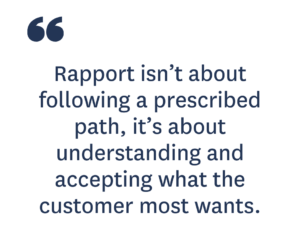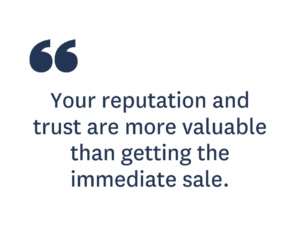In the digital era, customer rapport rules the day. People expect more communication and personal connection than ever before. That being said, building rapport with clients in the digital era is also more complex than ever before.
People are finding your company through a variety of methods and platforms, and yet they expect extreme personalization.
It’s hard, but hard doesn’t mean impossible.
I’m going to show you — step-by-step — how to build rapport with customers at each stage of the customer lifecycle.
But first, before we talk about how rapport building works, we’ll start by answering the common question: “what does rapport mean exactly?”
What is Rapport?
A rapport is a connection or relationship with another person. It can also be defined as a state of harmonious relations with another individual or group.
Rapport Building
Building rapport can be defined as the process of developing a connection or relationship with another person.
The Importance of Good Rapport
Good rapport is vital because it allows us to connect and build relationships with others, at personal and professional levels. It also helps establish a comfortable environment, both for work and living.
How Do You Build Rapport Fast?
Building rapport requires good use of social skills such as eye contact, sharing, cooperation, and listening. Here are a few pointers on how to develop rapport fast in your living and working environment.
Read: How to Build Genuine Rapport in Sales
1. Research the person
For you to have meaningful conversations, you need to know more about the person you are engaging with. Find out as much as you can about the individual e.g interests, likes, hobbies, and background.
Good sources of information include:
- Their social media profile
- Their LinkedIn page
- A quick Google search
Conducting research on the other person helps create common ground and also makes room for shared experiences between the both of you.
2. Actively listen
Active listening entails giving your full attention to the individual you are conversing with. It’s an important communication skill as it encourages openness and honesty. You want the other person to feel seen and heard — the more you show that you are actively listening, the more the other person is inclined to share more.
Also, when actively listening, make sure you are listening to understand, not just to give a response. It shows that you are interested in whatever they have to say. Sometimes we formulate responses even before the other person is done speaking. This is an indicator of poor communication skills. Here’s a little secret on how to correct such a situation: after the other person is done speaking, take some time to think about what they just said, then give your response.
3. Mirror and match
Mirroring and matching are techniques that aim at making yourself more like the other person. Here are some examples of the techniques:
- Watch the other person’s body language e.g posture and expression and try to match whatever they’re doing.
- Use similar language. If they are using technical language, then a good idea would be to emulate the same.
- Match the other person’s speech patterns such as tone and tempo. If they are speaking at a low tempo, then soften your voice so that you are both using the same tempo.
4. Be friendly
Another tip on rapport building is to be warm and approachable when interacting with the other person. The best way to go about this is to smile often. Smiling shows openness and also helps develop rapport with the other person.
Another tip is to make eye contact. It shows that you are listening and acknowledge what the other party is saying. Be open to sharing and receiving information. However, don’t try to force the feeling — you may come off too strong and likely repel the individual.
Find a balance in the amount of information you share about yourself. Don’t give out personal relationships such as dating history, it’s a conversational faux paus, especially in a formal setting.
5. Ask questions
One of the best ways to indicate that you are listening and are invested in the conversation is to ask questions. Asking follow-up questions during a conversation demonstrates interest that you genuinely want to understand the other person’s point of view.
Communication and Interpersonal Skills For Rapport Building
Communication Skills
Communication skills are abilities you use when giving and receiving information. They are a part of our day to day lives and ensure clear and effective communication. These skills involve:
- Listening
- Speaking
- Empathizing
Examples of Communication Skills include:
Active Listening
Active listening is defined as paying attention to the person you are conversing with. It involves getting rid of distractions such as mobile phones and laptops, focusing your attention on the speaker, and maintaining eye contact.
Active Listening shows interest in what the other person has to say and helps create a relaxed atmosphere between you.
Friendliness
Friendliness may include smiling, honesty and thoughtfulness such as when you remember specific details of a conversation. It indicates openness and helps develop a rapport with the other person.
Giving and Receiving Feedback
Good communicators are open and accepting of feedback while also providing constructive insight to the other individual. Feedback at the workplace is important as it helps identify areas that require development.
Empathy
Empathy illustrates that you not only understand where the other person is coming from but that you share in their emotions too. It encourages openness in conversations and makes individuals feel seen, heard, and understood.
It’s an important skill at the workplace and in informal arrangements.
Respect
Respect is an extremely important factor in all human relationships. Respect in communication involves giving the other person space and time to articulate their thoughts and feelings, without interruption.
Other aspects of respect include staying on the topic of discussion and responding clearly to questions.
Interpersonal Skills
Interpersonal skills can be defined as traits that one relies on when communicating with others. They are also known as people skills or soft skills, including verbal and non-verbal elements of communication.
These skills are important at building rapport with customers, relating with colleagues and superiors, and even in personal relationships.
Examples of interpersonal skills include:
- Empathy
- Motivation
- Leadership
- Assertiveness
- Active listening
- Teamwork
- Decision making
- Conflict resolution and mediation
How Do You Build Rapport With Customers In 5 Steps?

Thanks to increased transparency with information and knowledge sharing, customers will typically come to you more educated about your area of expertise than those in the past.
This can lead to a mixed bag, but the upside of such a situation is that you can immediately move to a higher-quality, more intricate level of conversation with the customer.
This also means that being upfront and honest with your customer is extremely important. Deception is much easier to sniff out when your prospect has so much information. That’s the quickest way to lose any rapport you might have had — so don’t do it.
The good news is that you don’t necessarily have to start from the beginning with every client. You have to play this by ear, but in many cases, by the time they’ve contacted you, they’re convinced and ready to buy.
This may mean the normal communication and sales cycle goes out the window.
However, we’re going to look at how you build rapport throughout a more normal process. Just remember, you may actually start further down the sales cycle.
RELATED: 10 Tips to Build Rapport Internally to Navigate Complex Deals
Step 1: First call
Some customers will find you through word-of-mouth, while others discover your service via online search.
Regardless of how they reach you, you should need a solid first touchpoint that brings them from the virtual world into your sales funnel.
That means setting up a preliminary call between them and a member of your business development team to gather the basics.
Have someone on your team call them within the first 48–72 hours of first contact to get a better picture of what they need from you.
Arm your team member(s) with a list of 8–10 questions to learn more about what the client needs and what they’re looking for.
These questions may include:
- Budget
- Resources
- Future needs
- Location
- Preferences
- Dependencies
- And more
This doesn’t have to be a long, intense conversation. The key here is to make contact and get a clear picture of what they need, so you can begin to put together a solution.
Step 2: Second call
After that first call, let the customer know they will hear from an agent in the coming days.
The agent will begin that call with the notes taken from the first call, and with a list of suggested solutions to directly appeal to the customer.
This level of curated consideration is what today’s consumers are looking for.
Don’t make the customer repeat what they need.
Everyone has been burnt out on automated, robotic conversations that are so prevalent with online technology. You can separate yourself by committing to personalization and by building rapport.
Show the customer that you’ve done your research between the two calls, and lead them to the next stage, where they can begin to see the fruits of your labor pay off.
Leading them through the process this way is smart for both you and the customer.
For the customer,they are heard not once but twice before you ever meet in person, and they have hopefully developed a sense of trust through that process.
The hope is that they gain some appreciation for the way your team has dedicated themselves to their cause. If this becomes tedious and labor-intensive for them, read the room and adjust accordingly.
For the company, this gives you the chance to vet leads — before the first meeting. Things to identify are:
- High or low intent
- Level of interest
- Desire to move quickly, slowly, or not any time soon.
This call is all about managing and maintaining expectations of what’s to come for everyone.
Step 3: First in-person interaction
This is probably the most important interaction you’ll have. It’s the first test of whether your sales team has the solutions the customer needs.
You’ll arrive at this meeting (or Zoom call) with several suggestions. Make sure your ideas and suggestions are more beneficial than those of your competitors.
You need to be able to demonstrate, to the last detail, that your proposals solve the problems the customer described.
It’s always better to come with multiple ideas because it allows them to compare and contrast their paths forward. This can help them narrow down, and define, what they want.
Only giving one option might seem to convey confidence, but if they don’t go for it, and you don’t have a backup plan, you will be left looking unprepared.
RELATED: 9 Shrewd Negotiation Tips Proven to Close More Deals
Throughout this meeting — however long it lasts — make sure you stay true to the task at hand while following their lead.
If they want small talk, go for it.
If they wish to keep things close to the chest, that’s fine, too.
Rapport isn’t about following a prescribed path. It’s about understanding and accepting what the customer most wants.
It’s your job to give the client what they need, as best as you can.
In this digital era, when everyone is ranking and rating everyone else after the sale, you’ll want people to be satisfied with what you showed them — even if it didn’t necessarily lead to a sale.
Your reputation and trust are more valuable than getting the immediate sale. If you play the long game and make establishing rapport the priority, you’ll wind up in the right spot.
Step 4: Follow-up interaction
After your first meeting, your follow-up will depend on how the customer responds. If they wind up signing on, that’s great. If not, you’ll want to keep in touch with them, and maybe bring them more ideas and solutions to consider.

It’s not a disappointment if you don’t get the sale right away, but you do want to be mindful of what the next steps will need to be to keep them interested.
Depending on your product or service, there could be a months-long sales cycle, and you may need to reiterate and reassure them that this can be normal.
Think of yourself as their partner in negotiating.
You’re their friend trying to help them get more benefit out of the deal, not just some guy trying to make a sale.
If you do that, you’ll earn their trust. You’ll also emerge from the time you’ve spent together with more knowledge and a clearer outlook on how to move forward.
Lean on your instincts and the rapport you’ve built so far to keep the conversation going. You’re the cool head in the room to ensure everyone stays cool, calm, and collected.
If you need to set up another in-person meeting, that’s fine and fair. However, make sure to send them an agenda for the meeting, so that there are no surprises, and so they don’t feel they’re just repeating the first one. You don’t want meetings for the sake of meetings.
Step 5: Future interactions
Assuming that you do find and offer the right solution for your prospect, you’ll want to check in at some point in the next few weeks or quarter to find out how it’s been performing for them.
This is not coming from a lack of confidence, and it’s important you don’t make it seem that way.
Rather, this is a chance to keep the positive interactions and experience going. They’re bound to have some feedback once they’ve actually used your product or service.
Continue to be available to them.
Make sure they know your customer service channels are open and encouraged. This will go a long way towards increasing the odds of repeat customers.
Lastly, these efforts to continue the relationship shows that you weren’t all talk when luring them toward a sale.
They will be impressed with your team, and they’ll be more likely to recommend you to others they know seeking similar services.
Rapport Building Is a Long Game
If you play the long game, you’ll impress.
If you continue to operate as if it’s 1994 — or even 2004 — you’ll be left behind for a competitor that has better evolved to communicate with your customer base.
During both the recruitment period and when focusing on retention, be sure to come across as caring humans, not programmed bots.
The rapport you can offer is immeasurable compared to templates or bots. Real relationships are what people are looking for these days. So give them what they need.







